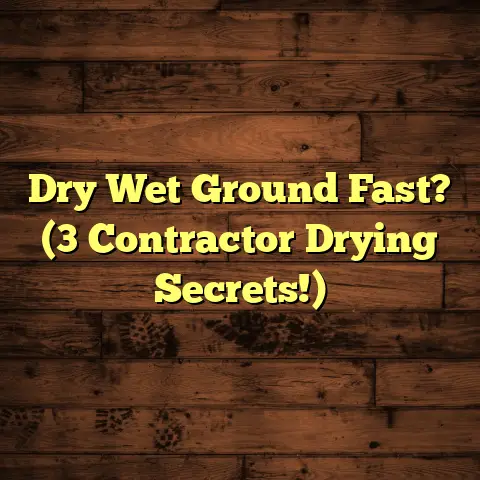Self Leveling Cement DIY? (2 Cracks To Avoid!)
I envisioned a sleek, modern space, perfect for morning coffees and afternoon reading. Self-leveling cement seemed like the magic bullet, the DIYer’s dream come true. I watched countless YouTube videos, read blogs until my eyes burned, and felt like I was ready to tackle this project head-on.
Armed with bags of cement, a mixing drill, and a squeegee, I dived in. The initial pour was exhilarating! The cement flowed smoothly (or so I thought), and I pictured myself relaxing in my newly renovated space in no time.
But then, the cracks started appearing. Tiny at first, almost imperceptible. But they grew, snaking across the surface like angry little rivers. Panic set in. What had I done wrong? Where did I mess up?
The experience was humbling, to say the least. It taught me more about self-leveling cement than any YouTube video ever could. It also taught me the importance of meticulous preparation and understanding the nuances of this tricky material. So, buckle up, because I’m about to share my hard- earned wisdom with you. We’ll explore the world of self- leveling cement and how to avoid the pitfalls that turned my dream sunroom into a cracked reality.
Section 1: Understanding Self-Leveling Cement
So, what exactly is self-leveling cement?
It’s a specialized cementitious mixture designed to create a smooth, level surface on uneven or damaged floors. Think of it as a liquid concrete that flows and settles on its own, filling in imperfections and creating a perfectly flat base for your final flooring.
Composition and Types:
Self-leveling cement typically consists of:
- Cement: The binding agent, usually Portland cement or a similar hydraulic cement.
- Fine Aggregates: Sand or other fine particles that provide bulk and strength.
- Polymers: These are key! They enhance flow, adhesion, and flexibility, reducing the risk of cracking.
- Additives: Various chemicals that control setting time, reduce air bubbles, and improve workability.
There are different types of self-leveling cement, each formulated for specific applications:
- Underlayments: These are the most common type, designed to create a smooth base for tile, carpet, wood, or other finished flooring.
- Overlays: These can be used as a final wearing surface, often stained or polished for a decorative look. They typically contain stronger polymers and aggregates for increased durability.
- Repair Mortars: Formulated for patching and repairing damaged concrete, these often have rapid-setting properties.
Benefits of Using Self-Leveling Cement:
For both DIYers and pros, self-leveling cement offers several advantages:
- Creates a Level Surface: This is the obvious one! It eliminates dips, humps, and other imperfections.
- Improves Flooring Installation: A level surface ensures proper adhesion and prevents issues like cracked tiles or uneven wood flooring.
- Saves Time and Labor: Compared to manually leveling a floor, self-leveling cement is much faster and easier.
- Versatile Applications: It can be used on concrete, wood, tile, and other surfaces.
- Aesthetic Appeal: It creates a smooth, modern look, especially when used as a final wearing surface.
Common Applications:
You’ll find self-leveling cement used in a wide range of projects:
- Leveling Concrete Floors: Perfect for basements, garages, and industrial spaces.
- Preparing for Tile Installation: Creates a perfectly flat surface for tile, preventing cracks and ensuring a professional finish.
- Renovating Existing Floors: Smooths out old, damaged floors before installing new flooring.
- Creating Decorative Floors: Can be stained, polished, or epoxied for a unique look.
Section 2: Preparing for Your DIY Project
Okay, so you’re ready to dive in? Great! But before you start mixing and pouring, proper preparation is key. Trust me, skipping this step is a recipe for disaster (and more cracks!).
Tools and Materials Checklist:
- Self-Leveling Cement: Choose the right type for your project. Read the manufacturer’s instructions carefully.
- Mixing Drill with Paddle: A powerful drill is essential for thorough mixing.
- Mixing Bucket: A large, sturdy bucket is a must.
- Spiked Roller: This helps release air bubbles from the cement after it’s poured.
- Squeegee or Trowel: For spreading and smoothing the cement.
- Primer: Choose a primer recommended by the cement manufacturer.
- Cleaning Supplies: Broom, vacuum, degreaser.
- Measuring Tools: Buckets for water, measuring cups.
- Safety Gear: Gloves, eye protection, dust mask.
- Level: To check the existing floor’s level and monitor your progress.
Step-by-Step Area Preparation:
-
Cleaning: This is crucial. Remove all dirt, dust, grease, paint, and any other contaminants. Use a degreaser if necessary. A clean surface ensures proper adhesion. I cannot stress this enough.
-
Repairing Cracks and Holes: Fill any large cracks or holes with a concrete patching compound. Let it dry completely before proceeding.
-
Priming: Apply a primer specifically designed for self- leveling cement. The primer seals the surface, improves adhesion, and prevents the cement from drying out too quickly. Follow the manufacturer’s instructions for application and drying time.
-
Measuring: Determine the area you need to cover and calculate the amount of self-leveling cement required. Most manufacturers provide coverage charts. Always buy a little extra, just in case.
-
Creating Barriers: Use masking tape or foam strips to create barriers around the perimeter of the area you’re leveling. This will prevent the cement from flowing into adjacent rooms or areas.
Assessing the Existing Floor Condition:
Before you even buy the cement, take a good hard look at your existing floor. Is it structurally sound? Is it relatively stable? If the floor is severely damaged or unstable, self- leveling cement might not be the best solution. You might need to address the underlying structural issues first.
- Check for Moisture: Moisture can wreak havoc on self- leveling cement. If the floor is damp, use a moisture meter to check the moisture content. It should be within the manufacturer’s recommended range.
- Identify Existing Cracks: Map out any existing cracks and assess their severity. Small hairline cracks are usually fine, but larger cracks might need to be repaired before applying the cement.
Safety Precautions:
Working with cement can be dusty and irritating. Always wear:
- Gloves: To protect your skin from irritation.
- Eye Protection: To prevent cement from splashing into your eyes.
- Dust Mask: To avoid inhaling cement dust.
Work in a well-ventilated area. If you have sensitive skin or respiratory issues, consider wearing a respirator.
Section 3: The Mixing Process
Alright, the area is prepped, you’ve got your tools, and you’re ready to mix! This is where things can get tricky. The mixing process is crucial for achieving the right consistency and preventing problems down the road.
Correct Mixing Ratios and Techniques:
The most important thing is to follow the manufacturer’s instructions. I know it sounds obvious, but trust me, it’s the most common mistake people make. Different brands of self- leveling cement have different mixing ratios, and deviating from those ratios can lead to serious problems.
Generally, you’ll be mixing the cement with water. The amount of water is critical. Too much water will weaken the cement, making it prone to cracking. Too little water will make it difficult to pour and spread.
Here’s the general process:
- Pour the correct amount of water into the mixing bucket. Use a measuring cup or bucket to ensure accuracy.
- Gradually add the self-leveling cement to the water. While adding the cement, use the mixing drill with paddle to mix continuously.
- Mix thoroughly for the recommended amount of time. Usually, this is 3-5 minutes. Make sure to scrape the sides and bottom of the bucket to ensure all the cement is mixed in.
- Let the mixture sit for a minute or two. This allows any air bubbles to rise to the surface.
- Mix again briefly before pouring.
Importance of Following Manufacturer Instructions:
I can’t stress this enough. Read the instructions! Different brands have different formulations and require different mixing ratios and techniques. Some might require a specific type of water, while others might have specific temperature requirements. Ignoring these instructions is like playing Russian roulette with your floor.
Tips for Achieving the Right Consistency:
The ideal consistency for self-leveling cement is a smooth, pourable liquid, similar to a thick pancake batter. It should flow easily but not be too runny.
- Use the right amount of water: Again, follow the manufacturer’s instructions.
- Mix thoroughly: Make sure all the cement is fully incorporated into the water.
- Avoid overmixing: Overmixing can introduce air bubbles into the mixture.
- Check the consistency: After mixing, pour a small amount of the cement onto a clean surface. It should flow smoothly and self-level without leaving any lumps or bumps.
My Mixing Mishaps:
Let me share a little story about my own mixing mishap. During my ill-fated sunroom project, I got a bit impatient and decided to add all the water at once. Big mistake! The mixture became lumpy and difficult to mix, and I ended up with a lot of air bubbles. The final result was a disaster – a weak, cracked floor that I had to tear out and redo.
The lesson? Patience and precision are key when mixing self- leveling cement. Don’t rush the process, and always follow the manufacturer’s instructions.
Section 4: Application Techniques
Okay, the cement is mixed, and you’re ready to pour! This is where you’ll see your hard work start to pay off. But application technique is just as important as mixing.
Applying Self-Leveling Cement:
- Pour the cement onto the prepared surface. Start in one corner of the room and work your way across. Pour in a continuous stream, overlapping each pour slightly.
- Use a squeegee or trowel to spread the cement evenly. Work quickly and efficiently to ensure the cement flows together smoothly.
- Use a spiked roller to release any trapped air bubbles. Roll the spiked roller over the surface of the cement while it’s still wet. This will help eliminate air pockets and ensure a smooth, even finish.
- Work in sections: If you’re leveling a large area, it’s best to work in sections. This will prevent the cement from drying out before you have a chance to spread it evenly.
- Maintain a wet edge: When working in sections, always maintain a wet edge. This means that you should always be pouring new cement onto wet cement. This will help prevent seams from forming between sections.
Tools for a Smooth Finish:
- Squeegee: A squeegee is great for spreading the cement quickly and evenly. Choose a squeegee with a flexible blade that conforms to the surface of the floor.
- Trowel: A trowel is useful for smoothing out any imperfections and creating a perfectly flat finish.
- Spiked Roller: As mentioned earlier, a spiked roller is essential for releasing air bubbles.
Working in Sections and Maintaining a Wet Edge:
Let’s say you’re leveling a large basement floor. Don’t try to pour the entire floor at once. Instead, divide the floor into sections, using masking tape or foam strips to create temporary barriers. Pour and spread the cement in one section at a time, making sure to maintain a wet edge between sections.
Avoiding Common Mistakes:
- Pouring too much cement in one spot: This can create puddles and make it difficult to spread the cement evenly.
- Letting the cement dry out before spreading it: Once the cement starts to dry, it becomes difficult to work with and can create seams.
- Walking on the cement before it’s fully cured: This can leave footprints and damage the surface.
My Application Faux Pas:
During another project, I was so focused on getting the cement spread evenly that I forgot to use the spiked roller. The result? A floor riddled with tiny air bubbles! It looked like a bumpy orange peel. I had to spend hours grinding down the surface to remove the bubbles.
The lesson? Don’t skip any steps! Each tool and technique is important for achieving a smooth, professional finish.
Section 5: The Two Cracks to Avoid
Alright, let’s get down to the nitty-gritty. We’ve talked about preparation, mixing, and application. Now, let’s focus on the two biggest culprits behind cracking in self-leveling cement:
Crack #1: Insufficient Surface Preparation
This is the number one reason why self-leveling cement fails. I know I’ve hammered this point home already, but it’s so important that it bears repeating.
How Improper Cleaning or Priming Leads to Cracking:
Imagine trying to glue something to a dirty, greasy surface. The glue won’t stick properly, and the bond will be weak. The same principle applies to self-leveling cement. If the surface is dirty, dusty, or contaminated with grease or oil, the cement won’t adhere properly. This can lead to:
- Delamination: The cement separates from the underlying surface.
- Cracking: The cement weakens and cracks under stress.
- Dusting: The surface of the cement becomes powdery and crumbly.
Priming is equally important. The primer creates a bond between the cement and the underlying surface. It also seals the surface, preventing the cement from drying out too quickly. If you skip the primer or use the wrong type of primer, the cement won’t adhere properly, and you’ll be setting yourself up for failure.
My Preparation Nightmare:
On one memorable (and not in a good way) project, I was in a hurry and decided to skip the degreasing step. I figured the floor looked clean enough. Wrong! Within a few weeks, the self-leveling cement started to crack and peel away from the surface. It was a costly and time-consuming mistake. I had to tear out the entire floor and start over, this time with meticulous preparation.
The lesson? Don’t cut corners on preparation. It’s the foundation of a successful self-leveling cement project.
Crack #2: Improper Mixing Ratio
We’ve already touched on this, but it’s worth exploring in more detail. The water-to-cement ratio is critical for the strength and durability of self-leveling cement.
How an Incorrect Water-to-Cement Ratio Leads to Weak Spots and Cracks:
- Too much water: This weakens the cement, making it prone to cracking and dusting. It also increases the risk of shrinkage, which can lead to cracking.
- Too little water: This makes the cement difficult to pour and spread. It can also create air bubbles and prevent the cement from self-leveling properly.
My Mixing Meltdown:
I remember one particularly frustrating project where I accidentally added too much water to the mix. The cement looked okay at first, but as it dried, it developed a network of hairline cracks. The floor felt soft and spongy underfoot. It was clear that the cement was too weak to support any weight.
The lesson? Measure carefully and double-check your measurements. A little extra water can have a big impact on the final result.
Section 6: Curing and Finishing Touches
You’ve poured the cement, smoothed it out, and avoided the two major cracking pitfalls. Now what? The final step is curing and finishing.
The Curing Process and Its Importance:
Curing is the process of keeping the cement moist for a certain period of time, typically 24-72 hours. This allows the cement to hydrate properly and reach its full strength.
-
Why is curing important? Proper curing prevents the cement from drying out too quickly, which can lead to cracking and weakness. It also helps the cement develop its maximum strength and durability.
-
How to cure self-leveling cement: There are several ways to cure self-leveling cement:
- Covering with plastic sheeting: This is the most common method. Simply cover the surface of the cement with plastic sheeting to prevent moisture from escaping.
- Spraying with water: Mist the surface of the cement with water several times a day.
- Using a curing compound: These are special chemical compounds that seal the surface of the cement and prevent moisture loss.
Protecting the Newly Poured Surface During Curing:
Keep foot traffic off the newly poured surface during the curing process. If you need to walk on the surface, wear soft- soled shoes or use plywood sheets to distribute your weight.
Finishing Options:
Once the cement is fully cured, you can choose from a variety of finishing options:
- Staining: Add color and character to the surface.
- Sealing: Protect the surface from stains and moisture.
- Epoxy Coating: Creates a durable, high-gloss finish.
- Installing Additional Flooring Materials: Tile, carpet, wood, or vinyl.
Conclusion
My journey with self-leveling cement has been a rollercoaster of triumphs and tribulations. I’ve learned valuable lessons about preparation, mixing, application, and curing. I’ve also learned that DIY projects can be incredibly rewarding, but they require patience, attention to detail, and a willingness to learn from your mistakes.
While self-leveling cement can seem intimidating, with the right knowledge and preparation, you can achieve a smooth, level floor that will last for years to come. Remember to avoid the two major cracking pitfalls: insufficient surface preparation and improper mixing ratio.
So, embrace your inner DIYer, grab your tools, and get ready to transform your floors! And don’t be afraid to make mistakes. That’s how we learn and grow. Just remember to learn from those mistakes and keep on leveling!





